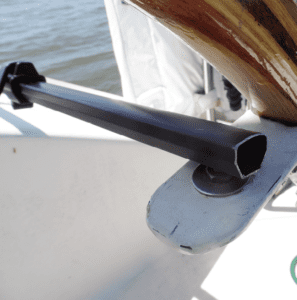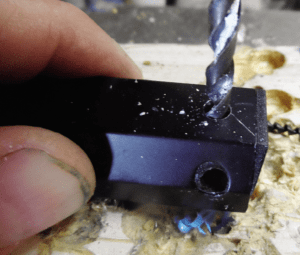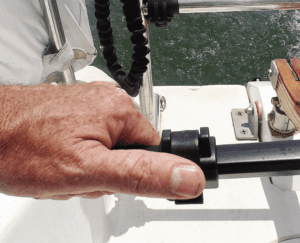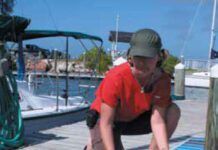An electronic tiller pilot is a marvel for single handed sailors. It is a second crew member that never tires, holding a steady course on long passages. On the other hand, it’s overkill when all you need is to hold course for a minute or less while hoisting the mainsail or making minor sail trim adjustments, and at $450-$800, they soar beyond the small boat sailor’s budget.
Even if you’re willing to bite the bullet, you still may not want to drag out the tiller pilot for every daysail. To engage, even for just a moment, you must adjust its length, click it into place, and adjust course some more, and finally switch to auto steer mode. You’ll need to secure the expensive unit so it won’t fall overboard, and then you’ll want to stow it below after use.
Of course, there is the age-old tradition of lashing the tiller, and there are several commercial locks. There’s the Davis Tiller-Tamer (PS Oct. 1, 1992), the Tillerstay (PS April 15, 1997), the Tillermate (PS April 1, 2005), and the Steer-iT (PS April 1, 2008) and the Tiller Tamer (PS December 2010), but prices start about $45 and go into triple digits. In a pinch you can use your tiller extender (see “The Many Faces of a Tiller Extension,” PS March 2021), but we came up with even a cheaper, simpler option.
If you’re looking for a lightweight manual tiller lock that fits standard autopilot fittings but is cheap enough to leave on deck, an old camera tripod is all you need.
THE MODIFICATIONS
Choosing among several at the local thrift store, I picked a reasonably tall one with sturdy legs, zero drag when sliding, and a fast, fingertip locking lever. It was missing a critical camera mount component, a common shortcoming of thrift store tripods, but I didn’t need that part anyway, so $5 got me three top quality legs.
The top leg pivot is a bolt. Save this to use as a swiveling pin. At the midpoint brace there is typically a rivet. Drill the head off and pull it out. Most legs are three sections; you’ll need just two. Use the top two, which are stronger. If possible, allow at least 8 inches of travel on either end of the centered position (the pin-to-pin length for Raymarine and Simrad tiller pilots when centered is 23.5 inches).
A ¼-inch hole is all that is needed to fit over the standard pin on the tiller. If you would like a snug fit, with no rattling, a rubber electrical grommet (available online or at your local hardware store) is an upgrade.
The swivel pin requires more work. About 1.5 inches long x 3/8-inch diameter, it can be cut from a bronze or brass bolt, or from aluminum rod. Stainless steel is overkill and hard to drill. Drill a hole near one end to match the top leg pivot bolt. Chamfer both ends with a file or sander. To allow the tiller lock to freely pivot, you’ll need to make a slot in the end of the leg. A drill and file will work. So will a hacksaw or Dremel tool. If you skipped the grommet step, wrap a thin ring of tape around the end of the smaller tube so that it cannot not slide fully inside the other.
Finally, add a light keeper cord with a clip to the butt end. Sure, your tiller lock cost you next to nothing, but it would be a shame to lose your handiwork overboard.
IN THE FIELD
Unlocked, you can’t feel its presence, although I don’t generally leave it in place while sailing, since it does limit the range of movement. To engage, flip the adjusting lever into the locked position. There is no slack and the tiller remains accurately positioned, maintaining a steady course for long enough to hoist the mainsail, make a trim adjustment, or duck into the cabin to fetch something. If the jib is snug and the traveler is eased, the boat should hold a close reach for a good long while.
No existing tiller pilot and mounting? You can buy the pin ($15) and socket ($19) from Raymarine, but there’s really nothing special about them, so fabricate your own from a ¼-inch stainless bolt and a 1/4-inch pipe nipple, reamed out slightly with a drill or file.
In fact, two boats ago I used a 3/8 x 6-inch brass pipe nipple in place of the factory supplied socket because I needed to raise the socket 3 inches higher; we reamed the end of the pipe with a drill and threaded the pipe into a hole drilled into a metal cross beam.
If you think you might add an electronic pilot later, note that the tiller pin must be 18 inches forward of the rudder pintle or bearing, and that the deck socket must be 23.5 inches to the side and about 1.5 inches lower (the socket can be port or starboard, which is selected in the set-up menu).
I love my Raymarine Tiller Pilot. It will hold course for hours while eating lunch, relaxing, or trolling. But I also like the simplicity and quickness of the manual version on days when I am sailing actively. And for those that may buy an electronic pilot in the future but can’t justify the cost just now, it’s a $15 solution.

1. A lanyard keeps the tiller lock from going overboard.

2. We used our existing tiller pilot pin, but you can make one from a 1/4-inch bolt or screw.

3. The aluminum pivot pin is easy to drill.

4. A slot in the end allows the tiller lock to pivot. We used a drill for most of the work, followed by a file.

5. You just need flick your thumb to set and release the stop.



































